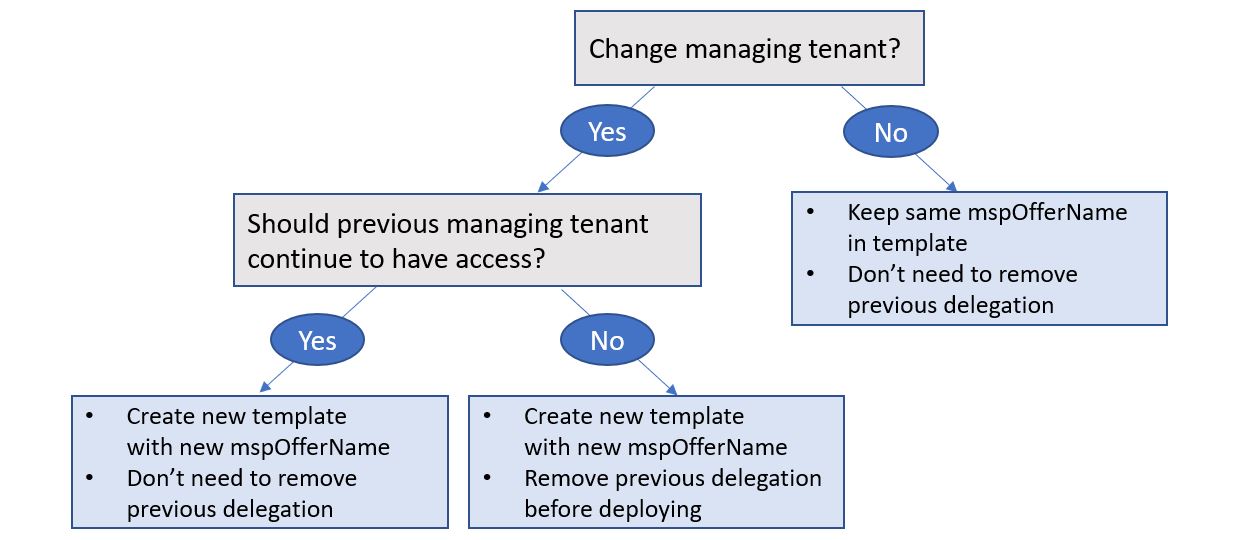Update a delegation
After you have onboarded a subscription (or resource group) to Azure Lighthouse, you may need to make changes. For example, your customer may want you to take on additional management tasks that require a different Azure built-in role, or you might need to change the tenant to which a customer subscription is delegated.
Tip
Though we refer to service providers and customers in this topic, enterprises managing multiple tenants can use the same process to set up Azure Lighthouse and consolidate their management experience.
If you onboarded your customer through Azure Resource Manager templates (ARM templates), a new deployment must be performed for that customer. Depending on what you are changing, you may want to update the original offer, or remove the original offer and create a new one.
- If you are changing authorizations only: You can update your delegation by changing the authorizations section of the ARM template.
- If you are changing the managing tenant: You must create a new ARM template using with a different mspOfferName than your previous offer.
Update your ARM template
To update your delegation, you will need to deploy an ARM template that includes the changes you'd like to make.
If you are only updating authorizations (such as adding a new user group with a role you hadn't previously included, or changing the role for an existing user), you can use the same mspOfferName as in the ARM template that you used for the previous delegation. Use your previous template as a starting point. Then, make the changes you need, such as replacing one Azure built-in role with another, or adding a completely new authorization to the template.
If you change the mspOfferName, this will be considered a new, separate offer. This is required if you are changing the managing tenant.
You don't need to change the mspOfferName if the managing tenant remains the same. In most cases, we recommend having only one mspOfferName in use by the same customer and managing tenant. If you do choose to create a new mspOfferName for your template, be sure that the customer's previous delegation is removed before deploying the new one.
Remove the previous delegation
Before performing a new deployment, you may want to remove access to the previous delegation. This ensures that all previous permissions are removed, allowing you to start clean with the exact users/groups and roles that should apply going forward.
Important
If you use a new mspOfferName and keep any of the same principalId values, you must remove access to the previous delegation before deploying the new offer. If you don't remove the offer first, users who had previously granted permission may lose access completely due to conflicting assignments.
If you are changing the managing tenant, you can leave the previous offer in place if you want both tenants to continue to have access. If you only want the new managing tenant to have access, the earlier offer must be removed. This can be done either before or after you onboard the new offer.
If you are updating the offer to adjust authorizations only, and keeping the same mspOfferName, you don't have to remove the previous delegation. The new deployment will replace the previous delegation, and only the authorizations in the newest template will apply.

Removing access to the delegation can be done by any user in the managing tenant who was granted the Managed Services Registration Assignment Delete Role in the original delegation. If no user in your managing tenant has this role, you can ask the customer to remove access to the offer in the Azure portal.
Tip
If you have removed the previous delegation but are unable to deploy the new ARM template, you may need to remove the registration definition completely. This can be done by any user with a role that has the Microsoft.Authorization/roleAssignments/write permission, such as Owner, in the customer tenant.
Deploy the ARM template
Your customer can deploy the updated template in the same way that they did previously: in the Azure portal, by using PowerShell, or by using Azure CLI.
After the deployment has been completed, confirm that it was successful. The updated authorizations will then be in effect for the subscription or resource group(s) that the customer has delegated.
Updating Managed Service offers
If you onboarded your customer through a Managed Service offer published to Azure Marketplace, and you want to update authorizations, you can do so by publishing a new version of your offer with updates to the authorizations in the plan for that customer. The customer will then be able to review the changes in the Azure portal and accept the updated version.
If you want to change the managing tenant, you'll need to create and publish a new Managed Service offer for the customer to accept.
Important
We recommend not having multiple offers between the same customer and managing tenant. If you publish a new offer for a current customer that uses the same managing tenant, be sure that the earlier offer is removed before the customer accepts the newer offer.
Next steps
- View and manage customers by going to My customers in the Azure portal.
- Learn how to remove access to a delegation that was previously onboarded.
- Learn more about Azure Lighthouse architecture.